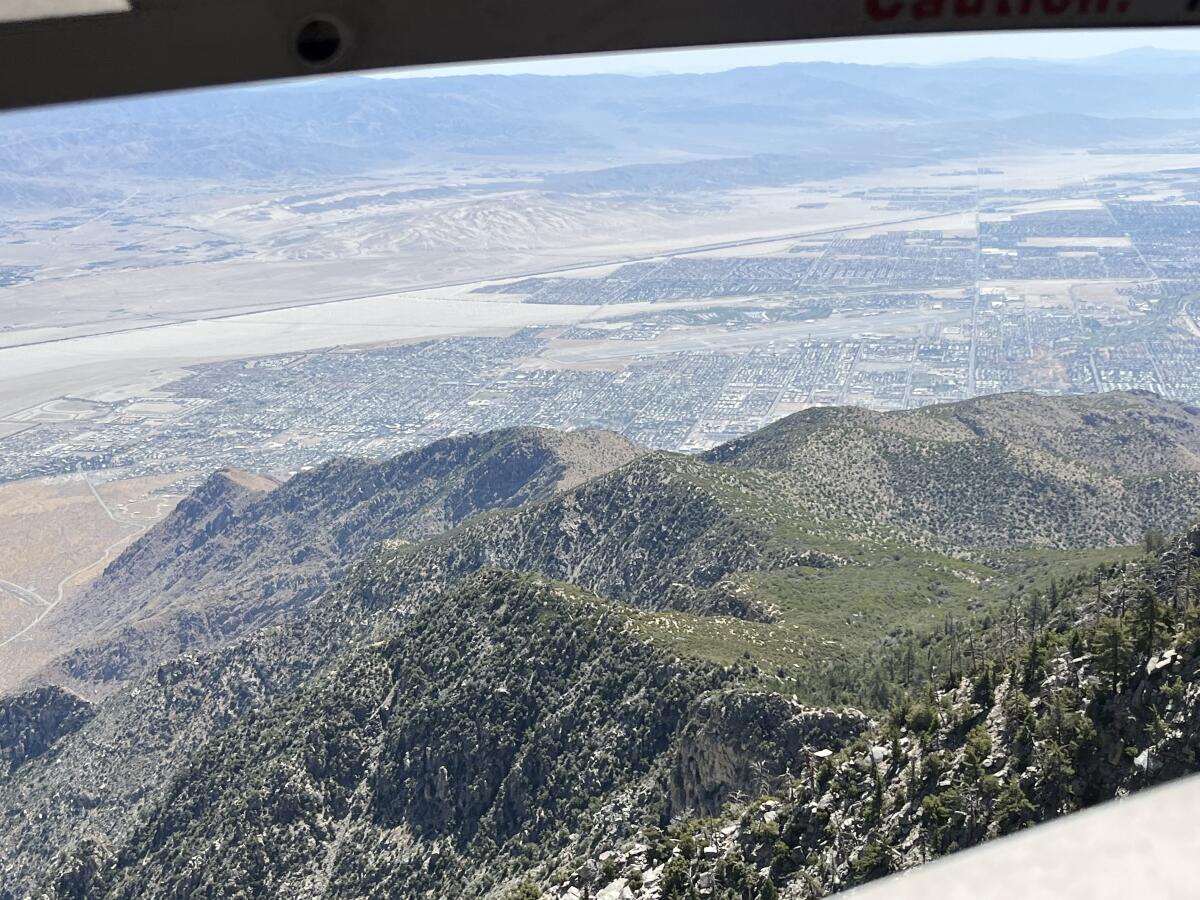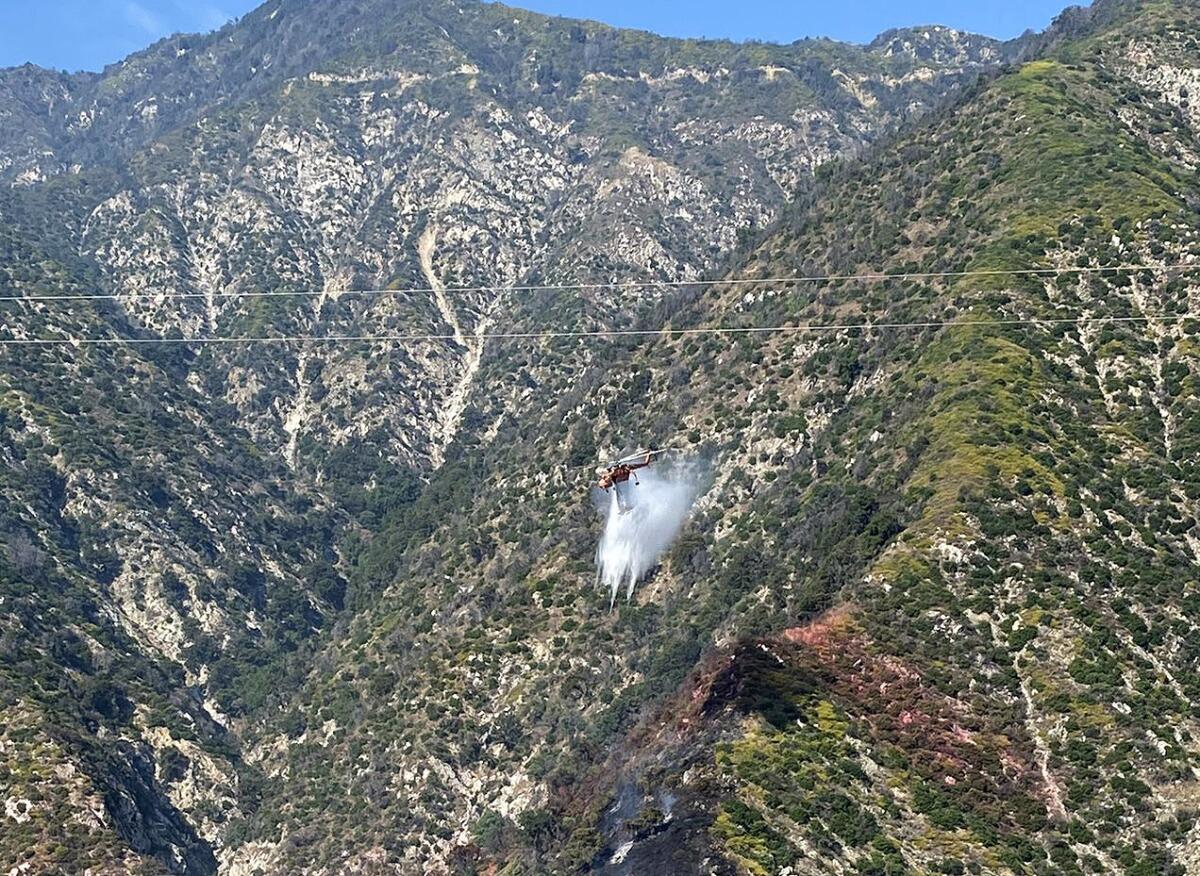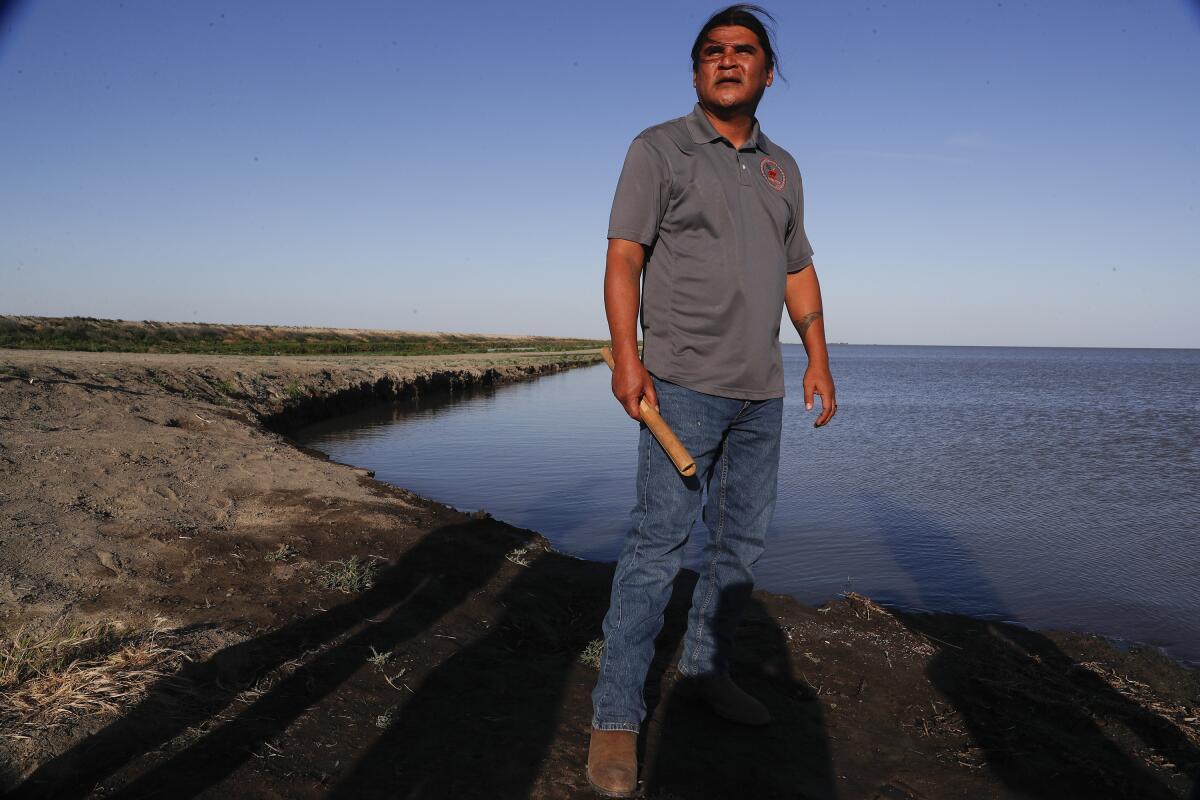Boiling Point: Hiking in the heat

- Share via
This story was originally published in Boiling Point, a newsletter about climate change and the environment. Sign up here to get it in your inbox.
Monday was the hottest day ever recorded on Earth. Then Tuesday was hotter.
That’s according to scientists at the University of Maine, who reported that average global temperatures on July 3 and 4 were the highest they’d ever seen, based on data going back to 1979. Many people almost certainly died of heat-related illness — some of them in Southern California, where temperatures reached 105 degrees in Los Angeles County.
The heat was even worse in Palm Springs, where I spent the holiday weekend with friends. To avoid the 116-degree highs, we took two trips up the Palm Springs Aerial Tramway, first hiking to the peak of Mt. San Jacinto and later returning for a downhill hike to the town of Idyllwild. The weather was gorgeous up in the mountains. So were the panoramic views.

My inbox and Twitter feed, meanwhile, were inundated with messages from readers frustrated with — or at least unsatisfied by — last Thursday’s Boiling Point newsletter, in which I wrote that rooftop solar alone can’t solve the climate crisis.
Beyond criticism of the research and numbers I cited, I heard from many people unhappy with the general framing of my recent coverage — including my in-depth story from earlier last week, about the need for sprawling solar farms in the desert.
Among the questions from readers: Why was I so focused on sprawling solar farms, when I could be writing about nuclear power or energy efficiency or some other climate solution? Why was I pitting rooftop and large-scale solar against each other, instead of reporting on the scourge of polluting gas plants? And for readers who love the desert, why couldn’t I see that giant solar projects are just another environmentally destructive tool for deep-pocketed companies to make even more money?
A few thoughts.
First: Yes, large-scale solar development can be profitable for corporations. If you’re not satisfied by strategies for phasing out fossil fuels that involve perpetuating U.S.-style capitalism, with all its inequities, that’s your prerogative. But as I suggested last year, tying climate action to a restructuring of the capitalist system definitely lowers the odds of success on climate.
Second: Every serious study examining what it will take to stop burning fossil fuels has come to the conclusion we’ll need a wide range of solutions. That means wind turbines, and geothermal plants, and reduced energy consumption, and public transit, and making city streets safer for walkers and bikers, and eating less meat — and, yes, rooftop and large-scale solar.
My goal in writing about rooftop solar not being enough — and about solar farms in the desert causing environmental harm — isn’t to pit technologies against each other. It’s to help figure out the right balance of climate solutions as time runs short.
Because time is very much running short. This weekend’s heat wave is only the latest reminder.
We already live in a world where baseball players wear face masks to protect their lungs from wildfire smoke. Where even a wet winter isn’t enough to prevent deadly blazes. Where droughts and floods and rising seas are in the news nearly every day.

The enormity of the climate crisis can be overwhelming, to the point where it can be easier for many people to engage with the issue through what the journalist David Roberts once deemed their “Climate Thing.” As Roberts wrote for Grist in 2015:
“Lots of people have a Climate Thing, that one tidbit of info or argument that they read somewhere, or heard somewhere, the thing that somehow resonated with their own concerns and beliefs. It’s the thing they latched onto, the thing they know about climate, like the proverbial blind people surrounding the elephant. They build on it and it becomes their Climate Thing.”
“A Climate Thing is not always wrong, though it frequently is. Just as often, it’s a kind of distortion, a lens that magnifies one aspect of the issue at the expense of all others. For some people it’s nuclear power. For some people it’s about models, how there was no warming when the models said there would be. For some people it’s Al Gore, or solar power, or consumerism, or population, or ‘I heard that we’re basically [screwed] no matter what,’ which I’ve heard more times than I can count.”
I’ve heard all of those Climate Things, too. I’ve written about many of them.
Can nuclear power help get us off fossil fuels? Yes, absolutely, although you still have to deal with the questions and controversy surrounding radioactive waste. Shouldn’t we be doing our best to use less energy and reduce consumption in general? Definitely, although even in a best-case scenario we’re going to need huge amounts of climate-friendly energy infrastructure.
And is it really worth slashing planet-warming pollution if it means paving over wildlife habitat with big solar farms?
Your answer will depend on your values, studies and life experiences. I made my own perspective clear last week, writing, “The sad truth is, not everything can be saved. Not if we want to keep the world livable for people and animals alike.”
But whatever your gut instinct, I’d urge you to contemplate the enormity of the threat facing our Earth and its inhabitants.
The threat was painfully clear to me over the holiday weekend, baking in the desert heat. Even going up the tram into the San Jacintos wasn’t a full escape. As I hiked through the mountains, it was hard to ignore the dead trees charred by past fires.
The world is changing. We need to change with it.
On that note, here’s what’s happening around the West:
HEAT AND SOLAR:

The Los Angeles Department of Water and Power will no longer shut off your electricity during a heat wave or cold snap if you can’t pay your bill. The new policy should help save lives, especially as fossil fuel pollution spurs more extreme weather, The Times’ Hayley Smith reports. Here are some tips for staying safe in the heat, via my colleague Dorany Pineda. And here’s a Media Matters for America analysis finding that just 5% of national TV news segments on the recent Southwestern heat wave mentioned climate change. In better news, E&E News’ Benjamin Storrow reports that solar power helped keep the lights on in Texas the last few weeks — a real problem for the anti-renewable energy narrative propagated by the state’s Republican leaders.
The California Public Utilities Commission rejected a request to revisit its December decision slashing financial incentives for rooftop solar. Details here from Sam Ribakoff at Courthouse News Service. Rooftop solar advocates may have better hope of success with an ongoing lawsuit against the agency, which I wrote about in May. Separately, the Public Utilities Commission voted to approve $4.3 billion for energy efficiency programs over the next four years, Utility Dive’s Kavya Balaraman reports.
The Biden administration raised a record $105 million auctioning off solar leases on public lands in Nevada, with most of the winning bids coming from Warren Buffett’s NV Energy electric utility. Here’s the story from Sean Hemmersmeier at the Las Vegas Review-Journal. And here’s a thoughtful look at a handful of groundwater wells going dry as solar developers add to the strain on underground aquifers in the California desert east of Palm Springs, written by Wyatt Myskow at Inside Climate News. In the nearby Coachella Valley, meanwhile, a prominent rooftop solar installer plans to launch a solar panel recycling business.
POLITICAL CLIMATE
Gov. Gavin Newsom reached a budget deal with California lawmakers that could speed up the environmental review and approval process for clean energy and transportation projects. My Sacramento-based colleague Taryn Luna wrote about the deal, which will also include a reduction in planned climate spending over the next few years. Not included in the deal: any provisions benefiting Newsom’s plan to dig a tunnel under the Sacramento-San Joaquin River Delta, which supporters say would help ensure reliable water supplies in Southern California and the San Joaquin Valley but which critics see as an environmental boondoggle. L.A. Times columnist George Skelton writes that the governor suffered a “humiliating setback” on the delta tunnel.
For the second year in a row, the California Senate passed a bill that would require the nation’s two largest pension funds to divest from fossil fuel companies — and for the second year in a row, lawmakers in the state Assembly killed it. Details here from Bloomberg’s Eliyahu Kamisher, who writes that the legislation won’t get a floor vote in the Assembly. Opposition from the fossil fuel industry may have contributed to the bill’s demise; just see this piece by Aaron Cantú at Capital & Main, noting that the Western States Petroleum Assn. has already spent $2.38 million on lobbying and advocacy in Sacramento this year.
Los Angeles Mayor Karen Bass removed the first and only Native American commissioner at the L.A. Department of Water and Power, Cynthia Ruiz. Indigenous leaders are outraged, The Times’ Louis Sahagún reports — including those in the Owens Valley, whose water Los Angeles effectively stole more than a century ago, with lingering environmental consequences. “We are in shock that Cynthia, the first Native American to serve on that commission, was replaced by a white man,” said Teri Red Owl of the Owens Valley Indian Water Commission. “For Native Americans, the manner in which Ruiz was replaced was a slap in the face.”
WATER IN THE WEST

Some Native Americans say California shouldn’t drain the newly reestablished Tulare Lake, but rather use the pooled floodwaters to bring back wildlife, recharge underground aquifers and help tribes recover some of the cultural rites that were taken from them by white settlers. My colleague Ian James wrote a fascinating story about the Indigenous argument for keeping Tulare Lake around, with The Times’ Jackeline Luna producing a powerful video on the same topic. The lake is already starting to shrink, though, prompting Gov. Gavin Newsom to claim victory. Farmers are certainly happy with that outcome. Ian wrote about a pistachio grower who is worried about losing everything after his fields were inundated by this year’s storms.
California’s Santa Cruz County agreed to spend $1 million to help prevent flooding along the Pajaro River, where recent storms displaced thousands of people in a farmworker community. Now the county is pulling back the money, my colleague Susanne Rust reports. “This is a big reason why work on these major types of flood protection projects often doesn’t get done,” one local official said. “When budgets start getting tight or when new priorities arise, then resources and focus are pulled away from the Pajaro River levee project. And then we look back years from now and wonder why the work didn’t get done again.”
Across the Colorado River and its tributaries, small groups of people are working to rebuild habitat for native birds, fish and trees, using the limited water supplies available. The Arizona Republic’s Brandon Loomis wrote a moving story about those efforts, exploring the idea that in ecosystems irrevocably altered by human activity, human hands are needed to restore some semblance of what existed before. Elsewhere in the Colorado River Basin, continued global heating may result in even worse water shortages in the Mexican city of Tijuana, where crumbling pipelines are also a problem, the Associated Press’ Suman Naishadham writes. Her story notes that the average U.S. family uses five times more water than the average Tijuana family.
THE ENERGY TRANSITION
As California struggles to clean up its unhealthy air, dozens of businesses that make baked goods, smoked meats, coffee, tortillas and more may be required to switch to cleaner electric equipment. The regulation being considered by air quality officials is designed to limit nitrogen oxide pollution, a major contributor to smog, as Brooke Staggs reports for the Los Angeles Daily News — although it could also reduce planet-warming greenhouse gas emissions. Staggs also wrote about why the Soboba Band of Luiseño Indians is building a solar-plus storage microgrid to power its casino in San Jacinto. Microgrids are just one small-scale alternative to sprawling solar farms — as are virtual power plants, which bring together rooftop solar panels and home batteries in a coordinated network. Inside Climate News’ Dan Gearino wrote about the growing success of those systems.
After 17 years, Idaho Power won a key approval in its quest to build a long-distance transmission line that could carry hydropower, wind energy and more between coastal and interior Western states. Portland Business Journal’s Pete Danko wrote about what comes next for the Boardman to Hemingway line, which will be built by Idaho Power but is majority-owned by Warren Buffett’s Berkshire Hathaway. In another interesting story about electric lines, the Wall Street Journal’s Katherine Blunt and Jennifer Hiller write that monopoly utilities are increasingly selling off solar and wind farms to fund badly needed — and lucrative — power grid upgrades. In California, meanwhile, Pacific Gas & Electric is seeking a nearly $7-billion federal loan to build new power lines — and prevent fire ignitions by burying existing lines. Details here from the San Francisco Chronicle’s Julie Johnson.
The Biden administration has proposed reducing fees for solar and wind development on federal lands by 80%. The proposal would also make it easier for companies to build renewable energy facilities across broader swaths of public land in the West, Akielly Hu reports for Grist. This comes a few weeks after I reported on concerns raised by solar companies that a separate Biden administration plan to improve conservation on federal lands could result in obstacles to clean energy development.
AROUND THE WEST

Is wildfire retardant a crucial tool for slowing the spread of flames, or an ecological nightmare? A new kind of retardant that can be applied along roadways as a preemptive measure is stirring up debate, The Times’ Hayley Smith reports. Both sides insist they’re right, with one environmentalist telling Hayley that fire retardant “has more adverse effects on endangered species than any other thing the federal government does, and there’s not even a close second,” while a former director of the California Department of Forestry and Fire Protection said retardant “plays a key role” in stopping deadly, destructive blazes.
An octogenarian couple just published a 500-page book on the birds of California’s Inyo County and Death Valley National Park. They’ve been working on it for decades, and ornithologists say it’s a masterpiece, my colleague Louis Sahagún reports. Big kudos to Tom and Joanne Heindel, who have been married for 69 years. Climate change is, of course, beginning to change which birds and other species are found in which places. That’s why the Mojave Desert Land Trust is building a seed bank in the town of Joshua Tree. Southern California News Group’s Brooke Staggs wrote about the nonprofit’s efforts to preserve biodiversity.
Climate change is coming for Sriracha. Personally, I have a low tolerance for anything spicy, so I’m not super worked up about the hot-sauce shortages fueled by drought in Mexico. But if Sriracha is your jam, The Times’ Nathan Solis wrote about how global warming is upending chile pepper production. In other food news, the federal government has for the first time approved the sale of chicken made from animal cells, as reported by JoNel Aleccia and Laura Ungar at the Associated Press. I’m curious to try lab-grown meat, at least when the price comes down — what about you?
ONE MORE THING

I love a good fireworks show — even when it’s sponsored by an oil company.
I celebrated the Fourth of July with family and friends at a park in El Segundo, where live music and excellent Salvadoran food preceded a spectacular in the sky. The event was sponsored in part by Chevron, owner of the oil refinery down the street.
Refinery connection aside, there’s no denying that fireworks are not good for our lungs.
Southern California regulators issued a preemptive warning about hazardous air quality. Diya Sabharwal, an L.A. Times intern hailing from New Delhi, wrote an essay about rampant fireworks pollution during Diwali celebrations back home.
“While I miss New Delhi dearly, I have come to love the clean smell of California’s air, and I am worried about what we stand to lose as the air continues to worsen,” she wrote. “The time is ripe to start advocating for a cleaner Fourth of July, so that we can prevent California’s future generations from ever needing a pollution break and feeling like they can’t go outside.”
Fireworks can also contaminate the ocean, with several Fourth of July shows along the coast canceled in the wake of new water pollution rules, my colleague Grace Toohey reports. The U.S. Forest Service, meanwhile, warned that fireworks can spark fires.
Does that mean we should all stop going to fireworks shows?
I’m not sure. But the first step toward solving a problem is admitting we have one.
To view this newsletter in your Web browser, click here. And for more climate and environment news, follow @Sammy_Roth on Twitter.
Toward a more sustainable California
Get Boiling Point, our newsletter exploring climate change, energy and the environment, and become part of the conversation — and the solution.
You may occasionally receive promotional content from the Los Angeles Times.






